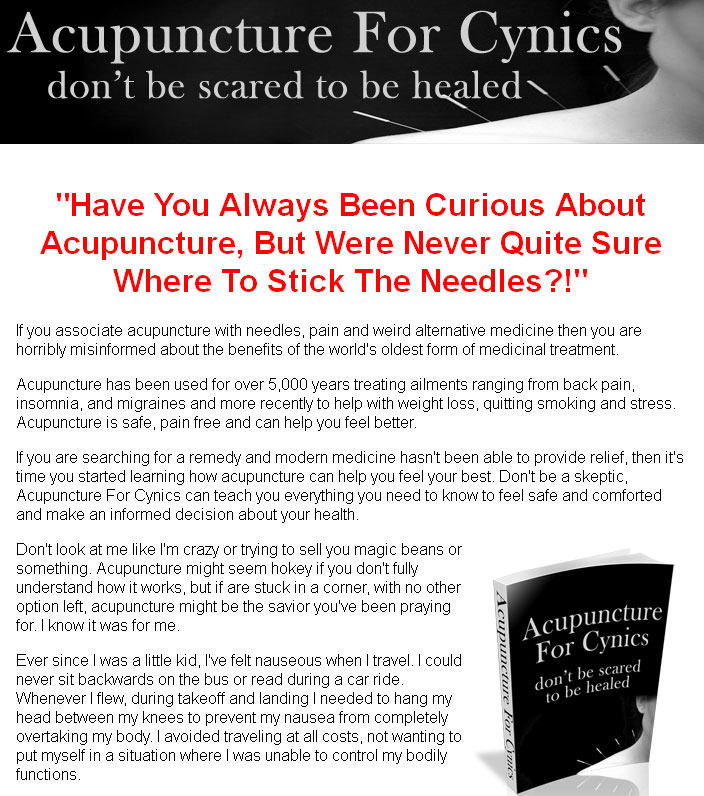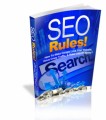Salespage Snapshot:

>>> Click Here To View Full Sales Page…
Table Of Contents
Introduction to Acupuncture . . . . . . . . . . . . . . . . . . . . . . . . . . . . . . . . 3
Origins and History . . . . . . . . . . . . . . . . . . . . . . . . . . . . . . . . 5
Conceptual Development . . . . . . . . . . . . . . . . . . . . . . . . . . . . . . . . 5
The Practice of Acupuncture . . . . . . . . . . . . . . . . . . . . . . . . . . . . . . . . 5
The Basics of Chinese Medicine . . . . . . . . . . . . . . . . . . . . . . . . . . 6
Yin and Yang . . . . . . . . . . . . . . . . . . . . . . . . . . . . . . . . 6
Chi . . . . . . . . . . . . . . . . . . . . . . . . . . . . . . . . 7
Zang Fu . . . . . . . . . . . . . . . . . . . . . . . . . . . . . . . . 7
The Five Elements . . . . . . . . . . . . . . . . . . . . . . . . . . . . . . . . 8
Why Acupuncture? – The Scientific Perspective . . . . . . . . . . . . . . . . . . . . . 9
Neuro-hormonal Theory . . . . . . . . . . . . . . . . . . . . . . . . . . . . . . . . 10
Hologram Theory . . . . . . . . . . . . . . . . . . . . . . . . . . . . . . . . 10
Fractal Theory . . . . . . . . . . . . . . . . . . . . . . . . . . . . . . . . 11
Chaos Theory . . . . . . . . . . . . . . . . . . . . . . . . . . . . . . . . 11
Physiology and Acupuncture . . . . . . . . . . . . . . . . . . . . . . . . . . . . . . . . 12
The Channels or Meridians . . . . . . . . . . . . . . . . . . . . . . . . . . . . . . . . 12
Acupuncture Points/Acupoints . . . . . . . . . . . . . . . . . . . . . . . . . . . 13
The Theory behind Acupuncture Points . . . . . . . . . . . . . . . . . . 13
Types of Acupuncture Points . . . . . . . . . . . . . . . . . . . . . . . . . . . . . 14
Non-Meridian Points . . . . . . . . . . . . . . . . . . . . . . . . . . . . . . . . 15
Types of Acupuncture . . . . . . . . . . . . . . . . . . . . . . . . . . . . . . . . 16
Sonopuncture . . . . . . . . . . . . . . . . . . . . . . . . . . . . . . . . 17
Electrical Acupuncture . . . . . . . . . . . . . . . . . . . . . . . . . . . . . . . . 18
Acupressure . . . . . . . . . . . . . . . . . . . . . . . . . . . . . . . . 18
Moxibustion . . . . . . . . . . . . . . . . . . . . . . . . . . . . . . . . 18
Japanese Acupuncture . . . . . . . . . . . . . . . . . . . . . . . . . . . . . . . . 19
Korean Acupuncture . . . . . . . . . . . . . . . . . . . . . . . . . . . . . . . . 19
Trigger Point Acupuncture . . . . . . . . . . . . . . . . . . . . . . . . . . . 19
Laser Acupuncture . . . . . . . . . . . . . . . . . . . . . . . . . . . . . . . . 20
Uses of Acupuncture . . . . . . . . . . . . . . . . . . . . . . . . . . . . . . . . 21
Weight Loss . . . . . . . . . . . . . . . . . . . . . . . . . . . . . . . . 21
Headaches . . . . . . . . . . . . . . . . . . . . . . . . . . . . . . . . 21
Quitting Smoking . . . . . . . . . . . . . . . . . . . . . . . . . . . . . . . . 22
Insomnia . . . . . . . . . . . . . . . . . . . . . . . . . . . . . . . . 23
Martial Arts . . . . . . . . . . . . . . . . . . . . . . . . . . . . . . . . 24
Respiratory Problems . . . . . . . . . . . . . . . . . . . . . . . . . . . . . 24
Disorders of the Eye . . . . . . . . . . . . . . . . . . . . . . . . . . . . . . . . 25
Gastro Intestinal Disorders . . . . . . . . . . . . . . . . . . . . . . . . . . . 25
Chronic Pain . . . . . . . . . . . . . . . . . . . . . . . . . . . . . . . . 26
How Safe is Acupuncture? . . . . . . . . . . . . . . . . . . . . . . . . . . 28
Conclusion . . . . . . . . . . . . . . . . . . . . . . . . . . . . . . . . 30
Sample Content Preview
Introduction to Acupuncture
Most of us have heard of acupuncture, but the truth of the matter is that for many of us, that’s as far as our knowledge of acupuncture goes. We know it involves sticking needles into our body to help relieve pain. But the very idea of needles probably sounds painful. However, this is not really the case.
Acupuncture is a branch of traditional Chinese medicine. This framework of medical practice begins with the belief that our body is a balance of two opposite yet inseparable forces – the yin and yang.
By the same line of thinking, this applies to the entire universe. Yin represents forces such as the cold, the slow and other passive forces, whilst Yang represents heat, excitement and other active forces. It is a combination of these forces and the balance between them that determines our mental and physical well-being.
Another cornerstone of traditional Chinese medicine is the concept of ‘chi’ (pronounced chee). Chi is the life force of the universe. In the body, it is the ‘chi’ that creates and animates life. We are all born with a certain amount of chi and continually acquire it throughout our lives through food, air, water and sunlight. Chi is believed to move through our body in channels called meridians. The quantity and quality of chi in our body depends on the state of our mental and physical balance (as represented by the yin and yang).
In fact, imbalances of the yin and yang in the body block the channels through which chi travels in our body. There are twelve main meridians (channels through which chi – our vital energy – can travel) in our body, eight minor meridians and over 2000 acupuncture points or acupoints which connect these meridians. The practice of acupuncture unblocks these chi pathways, thus ensuring the constant and free flow of energy through our body for mental and physical wellbeing.
Oriental medicine has some basic principles but they are not set in stone. Acupuncture and traditional Chinese medicine at large are tailored and modified to suit each patient. Furthermore there are many different schools of thought.
Traditional Chinese medicine is a complete healthcare system that is capable of providing both specialized and primary healthcare. It also gives us guidelines on how to prevent illnesses.
The bulk of traditional Chinese medicine’s roots lie in Taoism. Taoism is both a religion and a philosophy of life. The main focus of Taoism is the natural laws of the universe and our relationship to the universe.
Other Details- 40 Articles (TXT)
- Ebook (PDF), 31 Pages
- Salespage (HTML)
- 20 Ecovers (JPG)
- 1 Affiliate Templates
- Year Released/Circulated: 2008
- File Size: 2,309 KB
License Details:
[YES] Can be given away
[YES] Can be packaged with other products
[YES] Can be offered as a bonus
[YES] Can be edited completely and your name put on it
[YES] Can be used as web content
[YES] Can be broken down into smaller articles
[YES] Can be added to an e-course or autoresponder
[YES] Can be added to membership sites
[YES] Can sell Resale Rights
[YES] Can sell Master Resale Rights
[YES] Can be offered through auction sites














